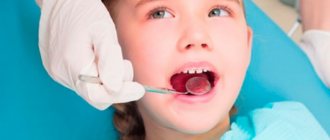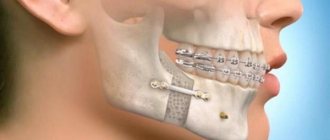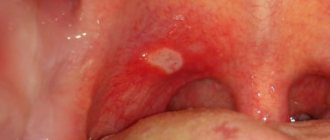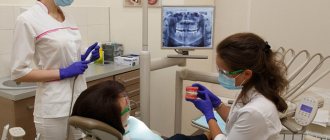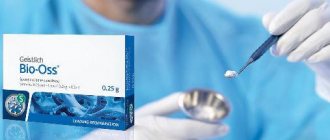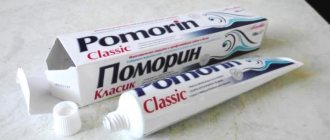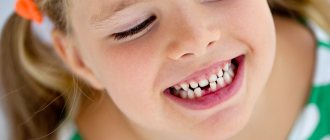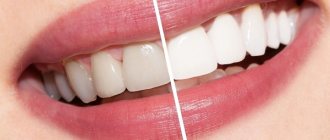The dental system performs the functions of breathing, swallowing, chewing and speech. It is a part of the body that changes dynamically throughout a person’s life. Its structure and functions reflect the development of the human psyche, the characteristics of his character, and behavior in society.
As the cultural level rises, people attach increasing importance to the shape of the face and the harmony of its structure.
Disorders in the maxillofacial area can be prevented by applying preventive measures and using the patterns of growth and development of the dental system.
II PERIOD - from birth to 6-9 months (before the eruption of the first milk teeth)
Prevention of dental anomalies:
- identification of congenital anomalies (cleft palate, lip) and development of a treatment plan
- rational regimen and balanced nutrition of mother and child
- breastfeeding baby
- correct artificial feeding of the child: correct positioning during feeding, preventing pressure from the neck of the bottle on the alveolar process, regulating the child’s efforts when sucking by squeezing the mother’s breast with the fingers, correct selection of the hole in the nipple, the length of the nipple and the degree of its insertion into the oral cavity, monitoring regularity swallowing
- identifying prematurely erupted teeth and deciding on their removal
Home | Pediatric orthodontics (part 2)
The period of mixed dentition is 6-12 years
The transition from primary to permanent dentition begins at the age of 6-7 years with the appearance of the first permanent molars, followed by the first permanent incisors. Permanent teeth erupt in groups. This period is called the “ugly duckling” period, as crowding of the permanent incisors is often observed, especially in the lower jaw. At the age of 8-9 years, the second incisors on the upper jaw erupt at an angle, which often frightens parents.
Crowding of incisors in a mixed dentition is not always an indication for orthodontic treatment. It all depends on the degree of crowding and the prognosis of the place in the dentition. Therefore, at the age of 6-7 years, you should definitely visit an orthodontist.
Also at this age it is necessary to begin orthodontic treatment if there are indications for correcting the bite.
To correct the bite during this age period, mainly removable appliances are used. Removable appliances include plates and functional appliances.
Orthodontic plates are plastic bases with metal fastenings on the teeth and additional devices (screws, springs). The plates are made individually according to the patient’s dentition models. The design of the plate depends on the type of bite of the patient and the position of the teeth. The main function of the plate is expansion. To do this, a screw is used in the plate, which is activated by the patients themselves, based on the doctor’s recommendations. The wearing of the plate is permanent; you can only take it off for meals.
Often, young patients do not comply with the regimen of wearing the plate, which gives rise to many myths about the ineffectiveness of the latter. The plate performs the expansion function well only when worn at least 22 hours a day with timely activation.
All removable devices cause rejection in the child. You need to get used to them, remember to take care of them, take them off for meals, and put them on again after eating. Often, when wearing an orthodontic appliance, speech impairment occurs, which causes difficulties for the child, especially at school. Orthodontic treatment with devices is long-term, about 2 years. Even with great enthusiasm at the beginning, many finish orthodontic treatment ahead of schedule without achieving results. Both children and parents get tired. Children from discomfort, and parents from constant monitoring and negotiations with the child.
I recommend treatment with removable appliances for those children in whom treatment at an early age will help avoid complex orthodontic treatment during the period of permanent dentition. These are malocclusions that require future orthognathic surgery, removal of permanent teeth, in order to correct the bite. It is possible that such patients with permanent dentition will need treatment with braces and aligners, but they will no longer need to remove healthy teeth or undergo surgery.
Another category of patients who, in my opinion, should be treated with removable plates are those whose treatment will take several months. At the same time, they will save themselves from orthodontic treatment, which lasts for one and a half years in permanent dentition.
The compulsory health insurance program includes bite correction for children. Therefore, having a policy, you have the right to receive orthodontic treatment for free. Correction of the bite and position of teeth in a children's dental clinic is carried out mainly with plates. Braces, trainers, and other high-tech devices are not paid for by the state. I recommend that parents who know that their financial situation will not allow orthodontic treatment with braces or aligners in the future to consult an orthodontist at a public dental clinic. First, assess whether your child is able to follow all doctor's orders and wear a removable device 24 hours a day for two years, as well as his ability to control this process.
The use of functional appliances during the period of mixed dentition helps to correct the most severe anomalies. Treatment of distal, mesial occlusion is very successfully carried out during the period of early change of teeth at the age of 6-8 years. Functional devices have different designs, depending on the purpose of use, and are manufactured individually according to the patient’s jaw models in a technical laboratory. These devices are plates on both the upper and lower jaws, welded together. The base of the device is plastic, in some cases it contains an expansion screw that is activated by patients. The metal components of the apparatus are attachments to the teeth, as well as various metal shields and pilots, lined with plastic, located in the vestibule of the oral cavity. The principle of operation of such a complex structure is to stimulate the growth of the jaw, the growth of which is necessary for the correct closure of the teeth. At the same time, the growth of the second jaw stops. Passive elements of the apparatus (cheek, labial pilots, shields) move soft tissues away from the dentition to stimulate growth; in some places, the pressure of the passive elements causes a decrease in development. The active elements (screw, springs) are activated by the orthodontist at scheduled appointments, and also gives recommendations for self-activation at home. Unfortunately, for all their effectiveness, these devices (such as the Frenkel apparatus) are very cumbersome and cause extreme discomfort for the child, even compared to a plate. At first, the pressure of the functional apparatus on the teeth and soft tissues is such that the child may experience irritation and chafing in the oral cavity, accompanied by pain. In this case, it is impossible to reduce the pressure of the parts of the device, otherwise it will be ineffective. Wearing these devices causes problems with diction, especially at first, and often changes in facial features. These designs require wearing 24 hours a day, with the exception of meals. Also, these devices, like all orthodontic devices, require careful care. The duration of active treatment is 2 years, followed by a retention period requiring wearing only at night.
Twin blocks are successfully used plates for correcting malocclusion. Actively used abroad. They consist of two plates for the upper and lower jaws. The principle of operation is the forced advancement of the lower jaw to treat distal occlusion and stimulate the growth of the upper jaw to treat mesial occlusion. Like functional devices, twin blocks have passive elements in the form of lip pilots, shields, as well as active screws and springs. The standard treatment period is 2 years, the wearing regimen is constant.
It is advisable to use braces in mixed dentition in the presence of very pronounced gaps between the incisors, palatal eruption of the central incisors and other disorders related to the problems of the position of the upper incisors. In this case, braces are installed only on permanent teeth: incisors and first molars. As a rule, braces are not placed on the lower jaw in mixed dentition. The results of treatment with braces in this case are very good and do not require the patient’s motivation (they cannot be removed, unlike plates). The downside is that it requires careful hygiene, brushing your teeth after every meal, as well as resorption (absorption) of the roots of permanent teeth if the orthodontist does not work properly.
Trainers, LM - activators are passive orthodontic devices for two jaws, made of silicone in the factory of different sizes. The orthodontist selects the required trainer size for each patient depending on the child’s age. To select the LM-activator, teeth measurements are required. The difference between the LM-activator and the trainer is that the LM-activator has cells for the incisors of the upper and lower jaw. These devices are effective for minor deviations from the norm in the position of the teeth. Correction of malocclusion cannot be carried out using these orthodontic devices. The use of trainers is possible to prepare for full orthodontic treatment. For example, as a preparation for the treatment of an open bite associated with inserting the tongue between the teeth, a trainer will help with long-term use (for several years). The mode of wearing the trainer, like the LM-activator, is at night and 2 hours during the day. The use of these devices does not cause severe discomfort in children; they are quite easy to get used to.
All removable appliances should be cleaned twice a day with a separate hard-bristled brush and toothpaste or toothpaste. Rinse with running water after each meal and rinse your mouth. The child needs to carry a container for records with him in order to place the device there during meals. It is necessary to ensure that the plate is not subjected to strong pressure, as it may break; orthodontic devices should not be subjected to heat treatment (boil). If it breaks, you need to contact an orthodontist; the plate may need to be repaired.
At the age of 6-12 years, you should contact a pediatric dentist at least once a year. Timely detection of caries will help maintain the health of teeth, both milk and permanent. Early loss of baby teeth causes deformation of the entire dentition. There is a displacement of the erupting permanent teeth towards the removed milk teeth. Therefore, if there is a loss of a baby tooth and more than 1 year remains before the eruption of a permanent replacement tooth, replacement prosthetics are required to preserve space in the dentition.
Prevention of caries is important at this age. Immediately after eruption, permanent teeth are very sensitive to caries. Therefore, during the period of changing teeth, it is recommended to brush your teeth at least twice a day and use toothpastes containing fluoride and calcium. After eating sweets, it is recommended to rinse your mouth or at least wash it down with liquid.
Sealing the fissures of permanent teeth is a modern, very effective way to prevent caries. The procedure consists of covering with material the grooves and fissures of the tooth, where caries most often occurs. Fissure sealing is absolutely painless, does not require drilling of teeth, and takes little time. Subsequently, the patient only needs to monitor the safety of the sealant by visiting the pediatric dentist once a year.
The final change of teeth occurs at 10-13 years for girls and at 11-14 years for boys. During this period, many people begin orthodontic treatment with a brace system. Treatment with braces always has a positive result and does not require such discipline from the patient as wearing removable devices. Therefore, increasingly, orthodontists and patients themselves prefer to wait until all permanent teeth have erupted.
III PERIOD - from 9 months to 3 years (formation of temporary bite)
Prevention of dental anomalies:
- massage of the alveolar processes of the jaws for difficult eruption of baby teeth
- monitoring the sequence of eruption of primary teeth and their establishment in the dentition
- the use of medicated nipples that apply pressure to an overdeveloped area of the jaw
- preventing the development of bad habits: thumb sucking, constant sucking on pacifiers, placing a fist under the cheek while sleeping, etc.
- identification of habitual incorrect posture (standing, sitting, lying), postural disorders and flat feet
- therapeutic exercises, massage, orthopedic consultation
- normalization of lip closure, nasal breathing, correct positioning of the lower jaw with the help of therapeutic exercises and vestibular plates
- detection of dental anomalies. Orthodontist consultation. Dispensary observation
When is orthopedic surgery necessary?
For surgery on the jaw to correct the bite, the price is quite high, considering that the preliminary obligatory stage is the treatment of pathologies of the dental system with braces or other structures. However, in difficult cases, occlusion correction in a more conservative way is not possible.
Specialists resort to surgical intervention only if preliminary treatment is ineffective and the patient has indications for surgery:
- pronounced facial asymmetry;
- concomitant speech defects;
- deformation of the alveolar processes;
- violation of chewing function;
- bone dysplasia in the chin area;
- deformation of the facial skeleton of the upper zone;
- deformation of the cranial vault;
- lip failure, breathing problems;
- pronounced displacement of the lower jaw;
- combination deformation of the facial skeleton.
The pathology may be acquired or congenital. The cost of correcting a bite surgically directly depends on the complexity of the pathology. Correcting minor defects will cost less than correcting a complex of severe defects.
IV PERIOD - from 3 to 6 years (the period of formed temporary occlusion)
Prevention of dental anomalies:
- plastic surgery of a shortened or improperly attached frenulum of the tongue
- complexes of therapeutic exercises to normalize lip closure, position of the lower jaw and tongue at rest and during functions
- combating sluggish chewing, avoiding eating hard foods, learning to swallow correctly
- learning the correct pronunciation of individual sounds (“r”, “l”, hissing)
- planned sanitation and hygiene of the oral cavity using special-purpose products
- monitoring the depth of the incisal overlap and the shape of the dental arches
- identification of postural disorders, flat feet, teaching correct body position while standing, sitting, lying, walking
- introduction to outdoor games
Milk bite
Two stages of development: the process of formation itself and the formed bite. For each stage there are deadlines in which dental units erupt in order. The timing is determined by human physiology.
Appearance sequence
Babies are born toothless, although the rudiments are already present inside the gums. The process of teeth emerging is usually accompanied by tears, periodontal swelling and increased body temperature.
Teeth begin to erupt when the baby is three to four months old. This process lasts approximately three years. These are conditional boundaries that depend on the individual characteristics of each child.
Teeth erupt in pairs: the lower pairs appear first, and only then the upper ones.
Sequence of appearance of baby teeth:
- The central incisors begin to erupt in the fifth month of the baby’s life and end in the ninth.
- The lateral incisors erupt between five and seven months.
- Molars appear at the age of about a year, the process can last up to one and a half years.
- Fangs erupt between thirteen and twenty months.
- The remaining molars appear starting from the twentieth month of a child’s life and finish erupting at the age of two and a half years.
- Premature babies' teeth may start to erupt later.
Temporary occlusion has several distinctive features, which can be divided into groups according to stages of development. Formation period:
- the lower jaw develops more slowly than the upper jaw;
- the dentitions are located symmetrically;
- paired teeth do not completely touch each other.
Formed temporary bite:
- teeth move away from each other due to the fact that the jaw itself becomes larger;
- pronounced abrasion of all units;
- free space appears behind the molars.
You need to take care of your oral cavity from the very first tooth. First, cleaning is carried out using a fingertip, and then using a brush. Clean baby teeth with special pastes that do not contain abrasive particles.
Many people believe that baby teeth do not need to be treated, since over time they will be replaced by permanent teeth. It's not like that at all. The milk bite affects the formation of the permanent one.
Consultation with a specialist in the formation of primary occlusion may be necessary in the following cases:
- if the teeth grow unevenly and they do not have enough space in the oral cavity;
- teeth do not erupt in a timely manner or the rudiments of milk units are absent;
- jaw injury;
- removal of molars.
V PERIOD - from 6 to 9 years (initial period of mixed dentition)
Prevention and treatment of dental anomalies:
- detection of malocclusions and their orthodontic treatment
- planned sanitation of the oral cavity and regular hygiene using special-purpose products
- observation of the sequence of eruption of the first permanent molars, incisors and massage of the alveolar process
- selective grinding of unworn cusps of temporary teeth (usually canines)
- plastic surgery of a shortened or improperly attached frenulum of the tongue
- plastic surgery of a shortened or improperly attached frenulum of the upper or lower lip (if there is a diastema, three)
- removal of retained primary incisors and erupted supernumerary teeth
- identification of postural disorders, flat feet, therapeutic exercises and orthopedic consultation
- fighting bad habits of sucking and biting fingers, lips, cheeks, tongue, various objects, with habitual incorrect posture
- detection of nasal breathing disorders. Consultation with an ENT doctor. Sanitation of ENT organs. Removal of adenoids and velopharyngeal tonsils for orthodontic indications in cases of severe malocclusion
- the use of therapeutic exercises to normalize nasal breathing, swallowing, and posture
- training from a speech therapist in the correct pronunciation of individual sound phonemes
- early removal of the buds of 3 molars (wisdom teeth) at the age of 7 years
When is a mixed bite normal?
The following signs are considered the norm for a mixed dentition:
– the change of teeth begins at 6–7 years and is completed by 12–14 years;
– the roots of baby teeth dissolve over the previous 2–3 years, causing them to become loose and fall out;
- permanent units are formed under the milky ones, after they fall out - they begin to grow intensively, breaking through to the surface after 2-4 years. The final development and mineralization of permanent teeth occurs after 2–3 years;
– the jaw and dentoalveolar arch are actively growing, increasing in size;
– wide gaps appear between the teeth – this is the norm, since permanent teeth are larger than baby teeth and require more space.
Normally, baby teeth do not come into contact with permanent teeth. Otherwise, this is an anomaly caused by late loss of milk or early eruption of permanent ones. These cases are fraught with disruption of the functionality of the HFNS and require immediate contact with a dentist.
VI PERIOD - from 9 to 12 years (the final period of the mixed dentition)
Prevention and treatment of dental anomalies:
- planned sanitation and training in oral hygiene using special-purpose products
- identification of dental anomalies and their orthodontic treatment
- selective grinding of unworn cusps of temporary canines and molars
- plastic surgery of the shortened frenulum of the tongue, lips (according to indications)
- removal of erupted or impacted supernumerary teeth
- identification of impaired posture, flat feet, torticollis. Therapeutic exercises and consultation with an orthopedist
- combating bad habits and incorrect postures, including during sleep
- therapeutic orthodontic gymnastics to normalize lip closure, nasal breathing, posture
- teaching proper chewing, swallowing, speech
- monitoring the sequence of eruption of premolars, canines, second molars, finger massage in this area
- rehabilitation of ENT organs
How to prevent the development of anomalies?
Some parents mistakenly believe that deviations in the development of the jaws at the stage of primary occlusion are only temporary and do not need to be treated. This is wrong.
To prevent possible serious consequences that arise already during permanent occlusion, parents need to visit the dentist in a timely manner - the first visit should take place at the age of 2-3 years, if indicated, it is necessary to undergo an examination by an orthodontist.
It is also necessary to prevent the development of harmful orthodontic habits in a child: prohibit gnawing and sucking objects, intentionally swallowing incorrectly, breathing through the mouth with normal nasal breathing.
VII PERIOD - from 12 to 15 years (period of formation of permanent dentition)
Prevention and treatment of dental anomalies:
- identification of dental anomalies and their orthodontic treatment
- planned sanitation of the oral cavity, mandatory consultation with a periodontist to identify periodontal diseases and their treatment
- oral hygiene training, individual selection of hygiene and prevention products
- identification of postural disorders, flat feet, torticollis, therapeutic exercises and consultation with an orthopedist. Swimming, fitness classes
- identification of gastrointestinal dysfunctions, introduction to food hygiene, consultation with a therapist
- identification and elimination of calcium deficiency
- determination of skeletal ossification disorders and consultation with an endocrinologist
- introduction to risk factors
During the period of changing baby teeth you cannot:
- Pull or loosen teeth yourself.
- Chew hard candies and nuts.
- Use metal or sharp objects as toothpicks.
- Use hydrogen peroxide, alcohol and other strong antiseptics to cauterize wounds.
The timing of the replacement of primary teeth is considered very individual. The number of simultaneously fallen elements of the dentition and the duration of this period depend on many factors. It is not recommended to speed up the process. At the same time, the appearance of various deviations is a reason to contact a dentist.
VIII PERIOD - from 15 to 21 years (completion of the formation of permanent dentition)
Prevention and treatment of dental anomalies:
- sanitation of the oral cavity, hygiene, use of individual care and prevention products
- mandatory professional hygiene
- observation by a periodontist, consultation and treatment of periodontal diseases
- identification of dental anomalies and their orthodontic treatment
- introduction to food hygiene
- elimination of calcium deficiency
- restoration of crowns of damaged teeth
- restoration of bite height, alignment of occlusion, selective grinding of teeth
- timely prosthetics
- monitoring the eruption of 3 molars (wisdom teeth) and their timely removal
- identification of incorrect habitual postures, posture disorders,
- prevention and treatment of osteochondrosis
- sports, fitness, swimming
- eliminating risk factors
- formation of useful habits and skills
- surgical treatment of severe deformities of the maxillofacial area
Cost of surgery to correct bite
Dental clinic "Doctor Martin" is one of the best orthodontic centers. The clinic provides surgical services to correct the bite. Treatment is carried out in the Department of Maxillofacial Surgery by highly qualified doctors with extensive experience in performing similar maxillofacial operations.
The price of an operation to correct a bite can vary significantly depending on the range of planned services. The cost of treatment includes diagnostics, jaw modeling, surgery, hospital stay and observation during the rehabilitation period.
Despite the complexity of the operation itself, long-term rehabilitation and material costs, the surgical intervention meets the expectations of patients. As a result of the operation, it is possible to eliminate functional and aesthetic defects, as well as significantly improve appearance.
PERIOD IX - from 21 to 40 years (active functions of the dental system)
Prevention and treatment of dental anomalies:
- regular sanitation of the oral cavity, compliance with hygiene rules using special-purpose products
- observation by a periodontist, treatment of periodontal diseases
- professional oral hygiene
- restoration of crowns of damaged teeth
- replacement of missing teeth using implantation and prosthetics
- removal of 3 molars
- selective grinding of teeth and elimination of traumatic occlusion
- achieving multiple contacts between teeth with various types of articulation and occlusion of the dentition
- prevention of diseases of the temporomandibular joints
- food hygiene
- elimination of calcium deficiency
- sports, fitness, swimming
- identification and elimination of risk factors
- fighting bad habits
- prevention of secondary dentofacial deformations
no images were found
Nutrition during the period of changing baby teeth
The enamel of the molars is not fully formed when they erupt. This process lasts several years, so a nutritious diet with properly selected products is of great importance:
- Every day the child should eat food containing large amounts of calcium (milk and dairy products).
- In some cases, if the baby does not want to consume dairy products, it is recommended to take vitamins with a high calcium content.
- Fruits and vegetables, some of them should be consumed in solid form in order to more quickly dissolve milk roots and erupt molars.
- It is recommended to include fish dishes containing phosphorus in your diet twice a week. It is better to give children low-fat varieties, including pike perch, hake and pollock.
- Eliminate chocolate, white pastries and sweets from your diet. Sweet soda is considered the most dangerous for tooth enamel.
During the change of baby teeth, it is necessary to avoid the consumption of sticky or hard foods, including toffees, nuts and candies. Otherwise, you can damage the temporary tooth or cause it to fall out too early, which often causes problems in the growth of permanent teeth. In addition, children should not eat food that contains active dyes, which can negatively affect the color of the enamel of permanent teeth without the possibility of further changing it.
Treatment of malocclusion using a partial 2x4 brace system.
In order to set the desired direction of tooth growth during the period of mixed dentition, a partial 2x4 bracket system is used. The name of the system is due to the mechanics of fastening the braces: the orthodontic apparatus is installed on 2 molars and 4 front incisors. It is the first molars (“sixes”) and 4 frontal incisors that appear first, replacing the milk teeth.
Treatment of malocclusion with a partial braces system can be carried out on both the upper and lower jaws.
The duration of treatment is limited to the period of transition from a mixed dentition to a permanent one. After all the teeth appear, if necessary, partial braces will be replaced with full ones.
On average, the 2x4 design is used between the ages of 8 and 10 years.
